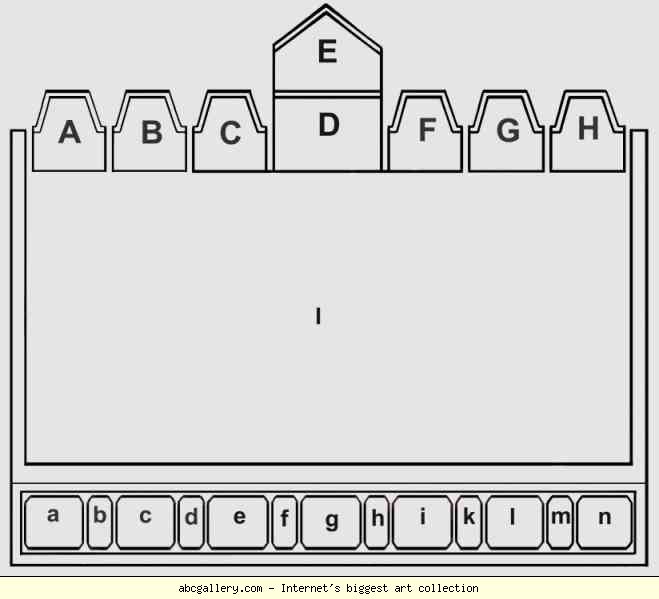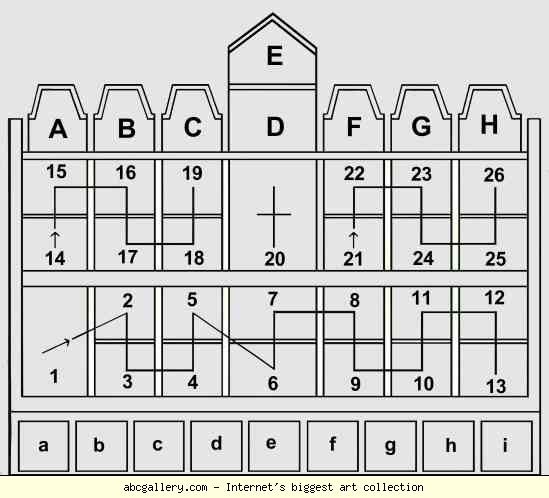Duccio di Buoninsegna
The Maestà
In 1308 the city of Siena
commissioned Duccio to produce a panel for the cathedrals high altar.
The work now is world-known under the name of The Maestà.
On June 9, 1311 the completed
painting was brought into the cathedral. A contemporary chronicler wrote:
And on that day when it (the Maestà) was brought into the cathedral,
all workshops remained closed, and the bishop commanded a great host of
devoted priests and monks to file past in solemn procession. This was accompanied
by all the high officers of the Commune and by all the people; all honorable
citizens of Siena surrounded said panel with candles held in their hands,
and women and children followed humbly behind. They accompanied the panel
amidst the glorious pealing of bells after a solemn procession on the Piazza
del Campo into the very cathedral; and all this out of reverence for the
costly panel
The poor received many alms, and we prayed to the Holy Mother
of God, our patron saint, that she might in her infinite mercy preserve
this our city of Siena from every misfortune, traitor or enemy.
The huge altarpiece originally
must have been over 5 meters (about 16.5 feet) high and 5 meters (about
16.5 feet) long. It was painted on both sides. The whole panel remained
on the cathedrals high altar until 1506, and was then displayed on a different
altar. Finally, in 1711 the decision was made to dismantle the altarpiece
in order to distribute them between the two altars. This dismantling, of
which there is a documentary record, is the reason for the works present
fragmentary state. At first the whole frame, the predellas and the crowning
sections were removed. Then the panel was sawn into seven parts. The two
predellas were each painted on a horizontally laid piece of wood, and could
therefore be taken apart easily. The main panel, however, posed a problem.
On the front, it consists of eleven boards arranged vertically, to which
five boards, laid horizontally, were nailed from the back. The wood, which
had been glued and nailed together, was very difficult to saw in two, and
in the process the picture-surface was severely damaged especially the
Madonnas face and garment. We owe the panels present state of presentation
to successful restoration in 1956.
The process of dismantling had
additional consequences. Once the whole structure had been broken up, several
individual scenes found their way to museums or private collections. Others
simply went missing. Thus, the picture we can form today of the Maestà
in its entirety is built up out of reconstructions, which have reunited
scattered scenes in a photographic montage. Every attempt is bound to be
incomplete, since the frame and five individual pictures have been lost.
Furthemore, art historians have not agreed on the sequence of scenes depicted
on both predellas and the reverse side. Even so, it is possible to form
an approximate idea of how the panel originally looked.
Hypothetical reconstruction of The Maestà
Front

Crowning panels:
A The Announcement of the Virgins Death
B Parting from St. John
C Parting from the Apostles
Probably:
D The Assumption of the Virgin (lost)
E The Coronation of the Virgin (lost)
F The Death of the Virgin
G The Funeral Procession
H The Entombment of the Virgin
Central panel:
I The Mother of God Enthroned with the Christ Child, amidst Angels and Saints
The main panel on the front depicts
Mary, holding her son on her lap. She is seated on an ornate marble throne
in the midst of angels and saints. The inscription around the base of the
throne contains two prayers. The Virgin is being asked to grant peace to
Siena and glory to Duccio who has painted the scene. On the left to the
throne, is St. John the Evangelist, he is depicted him as an old man with
a beard, holding a book; then Comes St. Paul with his sword, the
symbol of his martyrdom, and the last in the row is St. Catherine
of Alexandria with a palm branch. On the right, St. John
the Baptist has raised his hand to point towards Mary; then comes St. Peter
with a book, and after him St. Agnes holding a medallion
with a lamb.
In the foreground, four of the citys
patron saints are kneeling before the Madonna. On the left is Bishop Ansanus,
who used to baptize the inhabitants of Siena and was beheaded in the forth
century. Then comes Savinus, also a martyred bishop.
On the right are Crescentius, who died a martyrs death while still
a child under the Roman Emperor, Diocletian, and whose mortal remains were
transferred to Siena Cathedral in 1058. Finally comes Victor, the Christian
soldier from Syria, who was declared a patron of the city after 1288.
Above the main picture runs a frieze
depicting half-length figures of the apostles.
Predella:
The predella pictures underneath are
devoted to the childhood of Christ, with portraits of prophets separating
individual scenes. On the front of the altarpiece, therefore, Mary and
her motherhood form the focus of the pictorial content. The life of Christ,
whose beginnings under motherly protection are depicted in the predella
pictures on the front, is reserved for the scenes on the reverse.
a The Annunciation
b The Prophet Isaiah
c The Birth of Christ
d The Prophet Ezekiel
e The Adoration of the Magi
f The Prophet Solomon
g The Presentation in the Temple
h The Prophet Malachi
i The Massacre of the Innocents
k Jeremiah
l The Flight into Egypt
m Hosea
n Christ Disputing with the Scribes
Reverse
The episodes on the reverse side, which originally numbered 43 in total, were intended for spectators in the presbytery, who could get closer to the panel than the faithful who congregated in the main body of the church. The central section, with 26 scenes from Christs Passion, represents the most comprehensive Passion cycle, which has survived. In contains stories from all four Gospels. The sequence of pictures now offered in the Museo dellOpera del Duomo may not be correct. The series undoubtedly begins, however, at the bottom left with The Entry into Jerusalem, and ends top right with The Road to Emmaus.

Crowning panels:
The crowning panels of the reverse side depict scenes after His resurrection. Most probably the pairs of lost panels, which originally formed the central apex of the crowning section, will have been The Ascension and Christ in Glory on the Christ side (the reverse), and The Assumption of the Virgin and The Coronation of the Virgin on the Madonna side (the front).
A Christs Appearance Behind Locked Doors
B Doubting St. Thomas
C Christs Appearance on Lake Tiberias
Probably:
D Christs Ascension (lost)
E Christ in Glory (lost)
F Christs Appearance on the Mountain
G Christs Appearance to the Apostles
H The Descent of the Holy Spirit
Central Panel:
1 The Entry into Jerusalem
2 The Washing of Feet
3 The Last Supper
4 Christ Taking Leave of His Apostles
5 The Betrayal by Judas
6 The Prayer on the Mount of Olives
7 The Seizing of Jesus
8 Jesus Before Annas
9 St. Peter First Denying Jesus
10 Jesus Before Caiaphas
11 Jesus Mocked
12 Jesus Accused by the Pharisees
13 Jesus Before Pontius Pilate
14 Jesus Before King Herod
15 Pontius Pilates Second Interrogation
of Christ
16 The Flagellation
17 The Crown of Thorns
18 Pontius Pilate Washing his Hands
19 The Road to Calvary
20 The Crucifixion
21 The Deposition
22 The Entombment
23 The Three Women at the Tomb
24 Christ in Limbo
25 Noli me tangere
26 The Road to Emmaus
Predella:
The pictures of the predella on the reverse side depict the temptation and miracles of the Son of God.
a The Baptism of Christ (lost)
b Temptation on a Pinnacle of the Temple
c Temptation on the Mountain
d The Calling of St. Peter and St. Andrew
e The Wedding at Cana
f Jesus and the Samaritan Woman
g The Healing of the Blind Man
h The Transfiguration of Christ
i The Raising of Lazarus